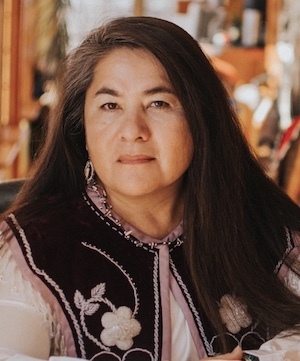Women's Rights & Issues
Related: About this forum100 Years After Suffrage, Native American Women Still Fighting to Vote
100 Years After Suffrage, Native American Women Still Fighting to Vote

Wmc features Louise Mc Donald Herne 082020 Louise McDonald Herne, condoled Bear Clan matron of the Mohawk Nation Council of Chiefs: “Women of all nations, step into your inherent authority, without apology.”
One hundred years ago, the 19th Amendment was passed, guaranteeing women in the United States the right to vote — or so the story goes. But after 1920, Native American women had to keep fighting for the right to vote in the U.S. — a struggle that continues to this day — despite a history of strong influence of Native American women on suffragist ideas, a history that still remains hidden to most Americans.Throughout most of the 1800s, leading suffragists Lucretia Mott, Matilda Joslyn Gage, and Elizabeth Cady Stanton were visiting, studying, documenting, and becoming increasingly influenced by the women of the Haudenosaunee Confederacy — six Native American nations more commonly known as the Iroquois Confederacy — because “Native women had power beyond their wildest dreams,” according to Sally Roesch Wagner, executive director of the Matilda Joslyn Gage Center for Social Justice Dialogue.
. . . .
From the very first encounters, the male European colonialist was threatened by matrilineal authority and was determined to destroy it. Early on, colonial authorities refused to interact with Iroquois women, who were removed from treaty negotiations. Once European men achieved dominance, they set about limiting the rights of both Native women and men to participate in the political system of the United States. For Native women, it was more than ironic that so much of the thinking of white suffragists was influenced by Six Nations women while the 19th Amendment didn’t guarantee Native American women the right to vote.
. . . . .
Ferguson-Bohnee reported several examples of “extreme distances Native voters must travel and the obstacles they must overcome in order to exercise their constitutional rights to vote”:
In 2008, the Alaskan government eliminated polling locations for Alaska Native villages as part of a “district realignment” that resulted in voters having to travel by plane in order to vote.
In the Southwest, non-Hispanic whites are 350 percent more likely to have mail delivered to their homes than Native Americans.
In 2016, the Pyramid Lake and Walker River Paiute Tribes in Nevada filed a lawsuit prior to the general election in order to get polling locations on the reservation.
Also in 2016, San Juan County in Utah switched to a mail-only voting system and offered in-person early voting only in the majority-white part of the county. In response, the Navajo Nation sued to ensure in-person locations and compliance with the language assistance requirements under Section 203 of the Voting Rights Act.
For the Kaibab Paiute Tribe in Arizona, in 2016 and 2018, voters had to travel 280 miles one way to vote early in person.
When Pima County closed early voting on the Pascua Yaqui Reservation in 2018, tribal members reported that they had to travel over two hours on public transportation to reach the nearest polling location.
The closure of polling locations on the Mandan Hidatsa Reservation in North Dakota resulted in voters having to travel 80–100 miles in order to cast a ballot.
. . .
The story of the Haudenosaunee women and the suffragists is nearly lost to history because ideas of women’s agency and equality retain their power to threaten the forces of oppression. Through their time with the Wolf Clan, the suffragists saw firsthand that there were societies in which women were not treated as inferior to men. Finally, women of all colors and from all corners of the United States are coming together to demand a democratic system designed to invite their participation. Now is the time to demand full political and social equality. In the words of Louise McDonald Herne: “A straitjacket imprisons our memory, and the newcomers to this land are stuck in a process where leaders rise to power by the campaigns they purchase. The land is a lady and ladies, you are the law. Women of all nations, step into your inherent authority, without apology. You’re a doorkeeper to life: Choose a leader, and legislate the full power of recall.
https://womensmediacenter.com/news-features/100-years-after-suffrage-native-american-women-still-fighting-to-vote
CaliforniaPeggy
(149,517 posts)...that all women are.
The problem is that we are beset with troubles on all sides. How do we decide what to do, and which fight to tackle first? It's overwhelming.
It pisses me off.
![]()